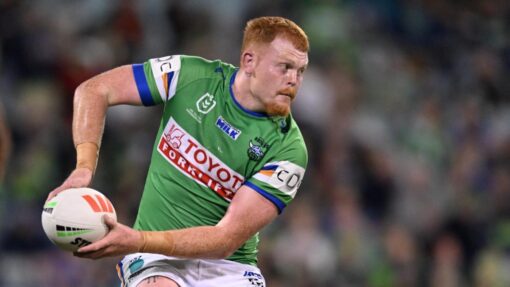NRL fine with Jake Trbojevic non-concussion call
Scott Bailey |

The NRL has revealed a Connor Watson push potentially saved Jake Trbojevic from being ruled out of Manly’s semi-final loss to the Sydney Rosters after his head knock.
Trbojevic was sent for an HIA early in Manly’s 40-16 loss to the Roosters on Saturday night, as part of a horror start to the game for the Sea Eagles.
The Manly lock suffered a head knock attempting to make the second tackle of the game on Lindsay Collins, before struggling to his feet and appearing dazed.
Players are often classified as showing category-one concussion symptoms after struggling to their feet, immediately ruling them out for the game.
But the NRL has confirmed Trbojevic’s case differed, because he had been pushed by Watson as he tried to regain his feet.
The 30-year-old subsequently passed his HIA, allowing him to play out most of the match.
“In the opinion of the independent doctor in the bunker, the signs that Jake exhibited were possible motor inco-ordination,” NRL head of football Graham Annesley said.
“Sometimes players are unsteady when they get to their feet without any reason to be unsteady.
“In this case what happened with Jake, when he hit the ground he was starting to get up again and he was pushed again.
“The bunker doctor took the view it was possible motor inco-ordination, as opposed to definitive motor inco-ordination, which would have been a category one.”
AAP has also been told the NRL’s match review committee closely analysed Jared Waerea-Hargreaves’ contact with Tolu Koula in the opening tackle of the game.
Koula’s head collided with Waerea-Hargreaves’ arm, with the Manly centre classified as showing category-one concussion symptoms and was ruled out immediately.
Waerea-Hargreaves found himself in hot water early in his career for using his forearm as a bumper in tackles.
But in this instance, the NRL determined that the Roosters prop only moved his arm forward after making contact with Koula, and did not lead with it.
The fact it was Waerea-Hargreaves’ ball-carrying arm was also taken into account, with the prop ruled to have only had a natural motion with his right arm around his chest.
NRL indicators for bumpers usually include the non-ball-carrying arm being held in front of the body in a horizontal direction, rather than vertical.
AAP


